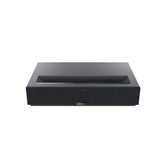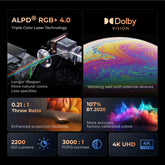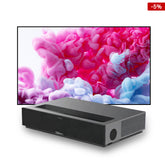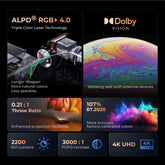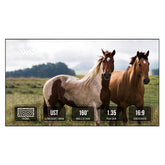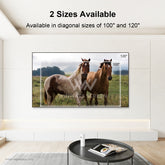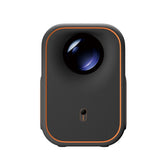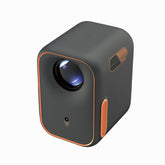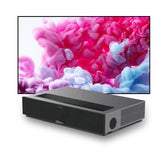The Evolution of Home Projector Technology
Since the primordial days of lifting hands and puppets above a fire to splash stories across a wall, projection has always been an inherently human form of entertainment. Generations of people used the wonder of light and specific angles to form visuals – creating stories and communities in their wake. Since those days, we’ve created new and exciting ways to create, communicate, and inspire through projection.
Projector technology has come a long way since its inception and is now a lucrative and growing industry in the entertainment sector. However, the projector power we see today had to undergo several updates and transitions to become the cinematic home theater systems we enjoy now – shifting eagerly from grainy and bulky stagnant displays to sleek 4k crystal-clear visual clarity. In this blog article, we take a closer look at the evolution of home projector technology and see how the strides made before our time have molded the innovations we have today.
The Magic of Reflection and Light – Ancient Projection
The phenomenon of Camera Obscura is one of the earliest natural occurrences that led to the projection technology we see today. Centuries ago, Ibn al-Haytham, an Iranian optical scientist, was the first to notice that if strong daylight entered a darkened room through a tiny hole in the window shutter or curtain, a dim, but clear inverted image of the outside world appeared on a white wall – or viewing screen - opposite the hole.

Sourced from Camera Obscura
As early as the 5th century, the Chinese and Japanese also took advantage of natural light and projection through the use of Magic Mirrors. In the 16th century, the first projectors were born using small flames and mirrors to project images onto screens. This was also the time in which Christiaan Huygens, a Dutch scientist, created the Magic Lantern - which was the earliest form of slide projector. It required a light source, a concave mirror to help intensify and focus the light, and a lens to project a painted picture from a glass slide onto a wall or projection screen. However, the only light sources available at the time were sunlight, candles, and oil lamps - which were very inefficient and produced very dim projected images.
In the late 18th Century, these lanterns were used to produce horror shows known as 'Phantasmagoria' shows. In these shows, a variety of horrific images were projected to frighten the audience. Coincidentally, the birth of film projectors was a crucial milestone in creating the modern home entertainment system. Edison and Dickenson introduced the 35mm film gauge in 1890 – setting a standard for filmography and setting a stage for later projection technology.
In the late 80s, opaque projectors were first used for demonstrations in front of large audiences. This was the earliest form of projection that displayed opaque materials by shining a bright lamp onto the object from above.
Start of an Era – Early 19th Century Projectors
Moving forward from the opaque projectors of the 80s, slide projectors became mainstream around the 1950s. These devices needed the presented material to be transferred to a 35mm slide - allowing the user to project virtually anything that can be put on film. In 2004, Kodak was the leading supplier of slide projectors and chose to discontinue production.
Following slide projectors, overhead projectors soon became the new trend – especially in schools and businesses. The technology was quite similar to slide projectors where the presented information had to be transferred to another medium to be viewed. However, this time it was a transparent and flexible sheet known as a “transparency.” Overhead projectors are still widely used today.
Towards the end of the 19th century, overhead projectors found further use with the introduction of digital projection panels. These consisted of a large Liquid Crystal Display (LCD), electronics, a cooling fan, and a plastic or metal enclosure with a glass plate on both sides. All this led to the moment when digital became the new norm in projector technology.
In 1973, Sony produced the first color projection system - the VPP-2100 which used the special Cathode-Ray Tube (CRT) video that evolved from Sony's Trinitron technology. The video images were projected through a large aperture lens onto a specially designed large screen with an effective screen size of 50 inches.
However, CRT projectors were very bulky and large – ensuring that they were quickly replaced by newer Tri-LCD and DLP technologies later on. This also ushered in a new age of Digital Light Processing (DLP), Liquid Crystal on Silicon (LCOS), and Liquid-Crystal Display (LCD) – now at much more affordable prices. These projectors were smaller, cheaper, and digital – immediately putting them miles ahead of the competition.
The Digital Dynasty
Digital projectors took center stage in the 1990s - quickly replacing older analog systems. These devices used digital imaging sensors instead of film - making them more efficient and less bulky. While digital projectors mostly became mainstream for theaters, they soon began to expand across the market for businesses, schools, and training. However, these innovative technologies still suffered from poor image quality, high costs, and limited portability.
A New Light – 20th Century Projectors
Moving into the new century, projectors began to take advantage of innovations such as 3D technology and 4K projection. 3D technologies allowed viewers to experience depth and dimension – adding an extra element of immersion to the viewing process. 4K resolution became a significant feature for home entertainment - boosting image clarity and details by multiplying the pixel count of Full HD four times over.
Soon this became the standard for visual entertainment and TVs and films were never the same. Laser projectors became a resounding innovation in the industry – improving image quality and enhancing colors seamlessly. Ultra-Short Throw (UST) projectors also became popular due to their convenience and quality display in smaller areas. These UST projectors were designed to be placed close to the screen or wall and use advanced optics and light sources to deliver big, bright, and clear visuals.
Typically, in darker rooms, a flat white surface is used to project the image of a UST projector. However, as time went by, those screens were also enhanced to get the full effect of a laser TV in any area by pairing UST projectors with Ambient Light-Rejecting (ALR) screens instead of the traditional white matte screens or a plain white wall. This is why the Formovie 100'' Fresnel Ultra-thin ALR Wall Mounted Screen is made with unique materials that are designed to reject nearly all the undesirable light in a room to focus on reflecting light from objects directly in front of it.
Elevating UST projector technology further, the Formovie THEATER revolutionized the home entertainment scene as the world's first Dolby Vision and Atmos 4K Laser UST projector and soon became a household name in the industry. The THEATER also made use of Appotronics’ ALPD® 4.0 feature to achieve a wider range of luminance and a more vibrant and expanded color gamut – all while remaining affordable.
The THEATER was only a continuation of Formovie’s pioneering projector technology after the release of the Xming Page One which became the world's first Google TV LCD Projector with Certified Netflix - bringing an unseen level of accessibility to entertainment. To elevate the level of visual clarity even more so, the Formovie’s Cinema Edge also harnesses the power of 4K Ultra High Definition to provide an extraordinary level of detail - making every image appear as lifelike as possible.
Today, the Formovie Theater Premium projector boasts the height of modern projector technology with an impressive 0.21:1 throw ratio that allows viewers to project a 100-inch screen from an even closer distance without moving the projector. Backed by industry-leading ALPD RGB+4.0 triple laser technology, the Theater Premium goes on to offer vibrant and true-to-life colors with advanced speckle suppression.
The Future of Projection Technology
Moving forward is crucial to creating new and exciting technologies that will change the way we see the world, tell our stories, and share special moments. Projector technology will see many improvements throughout the next decade – with technologies like ALPD® 5.0 and other innovations brewing on the surface. As we look back at all that has been achieved in the projector industry – from cave plays by fire to enhanced visual and audio clarity in the comfort of our homes – we can only hope to inspire future generations with the pioneering feats we’ve accomplished in our generation.













